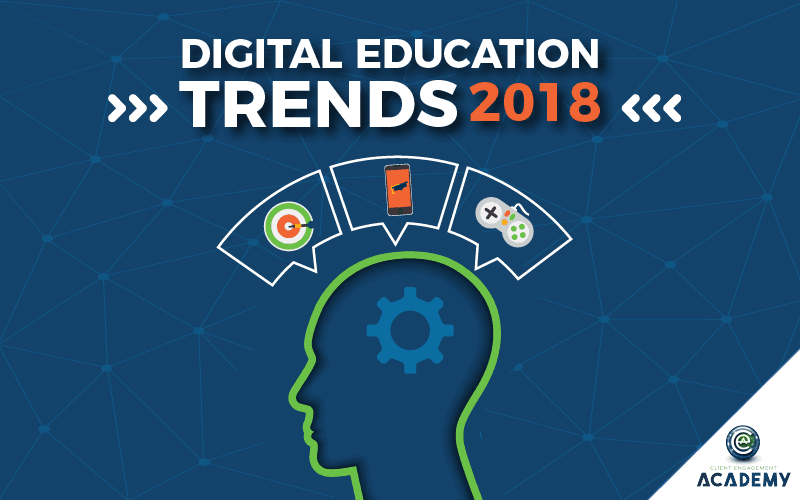
Innovation in educational technology and the shift to a digital world has necessitated huge changes from instructors, coaches, business owners, and entrepreneurs alike—they’ve had to make drastic alterations to not only the way they instruct, but to their entire business models, and at a much faster rate than predicted.
Investment in Educational Technologies Continues to Increase
Modern learners have the ability and the need to consume information precisely when and how they want it, and technology has been created to suit every learner’s unique lifestyle. Digital Education is receiving a never-before-seen level of growth in tools for content development, delivery, reinforcement, library cataloging, learner engagement, and cloud-based administration.
Here are some of the current trends making headlines for their impacts on student learning:
1- Classroom on a Smartphone
Between 2015 and 2020, the worldwide market for mobile-based learning is predicted to grow from US$7.98 billion to US$37.6 billion—a compound annual growth rate of over 36%.
Over 6 billion people now own smartphones and therefore have high-speed internet connectivity, making “m-learning” (mobile learning) more and more popular. In terms of overall internet use, mobile devices actually now surpass desktops. Formal education is taking a backseat to a more personalized, flexible, accessible, and interactive version of e-learning. Students are becoming increasingly empowered to pursue their academic dreams despite geographical and socio-economic divides.
In an analysis of Udemy’s 15 million online learners from all over the globe, mobile offline usage was seen to grow 69% between 2015 and 2016—telling researchers that they are progressively downloading more course material to consume on their devices on-the-go. On the same site, mobile learning has been found to be most popular between 6 and 9 am, during the morning commute.
Whether learners are using their smartphone for online classes depends in part on what they’re interested in learning. For leadership or personal lifestyle courses, m-learning was more popular: watching a marketing or meditation video is easy to do on the bus or at the beach. More technical topics like data science, however, require more concentration as well as a larger screen and a keyboard, so desktop access was a more popular choice.
Mobile apps help the modern professional learn a new skill on the go, allowing them to choose when and how to study. This means instructors must create “digestible content” to stay relevant. According to ZDNet, “Smaller screens force educators to deliver content in smaller chunks, which makes it easier for learners to remember what they learned.”
Mobile technology is giving instructors, coaches, business owners, and entrepreneurs the incentive to make their coursework accessible and memorable – two key aspects of impactful digital education and successful learning experiences.
2- Learning Lessons from Gamification
It’s a basic concept: when you enjoy something, you’re going to do it more, and eventually, the continued rewards will make it increasingly addictive.
What if your students got addicted to learning? Believe it or not, it’s possible—with gamification!
Sometimes gamification means producing an entire video game that includes educational value. At other times, it means implementing rewards and badges into online learning programs to increase incentives, coax the learner into more active participation, and inspire a light-hearted sense of fun. You may include features like customizable avatars and user interfaces, leaderboards, quizzes, puzzles, riddles, and ciphers, all in the spirit of encouraging learning, participation, team-building, and friendly competition.
Modern students want to know where they are and where they are going when they take an online course. Gamification offers that sense of progression with immediate feedback – giving students short-term gratification in regard to their long-term learning goals.
Educational theorists are divided on whether gamification actually works, but it’s certainly popular with its intended audience. Almost 80% of polled students say that they would learn better if their learning programs were more game-like. 62% are motivated by leaderboards and 89% said that a point-based system in an e-learning app would increase their overall engagement.
Drexel University’s Senior Vice President of Online Learning, Susan Aldridge, says games are powerful education tools as they mirror real-life issues and give students valuable skillsets. She says: “Virtual game worlds provide a unique opportunity to apply new knowledge and make mission-critical decisions while identifying obstacles, considering multiple perspectives, and rehearsing various responses.” In short, gamification is an extension of learning by doing.
Also, According to Embee, gamification is going to redefine the teaching and learning process in 2018. M2 Research predicts that gamification will be worth $2.8 billion by next year.
This kind of change seems to be right on time—the alarmingly high dropout rates reflect a general lack of student motivation, mainly attributed to systematic flaws in the current educational system.
Another study shows four ways that gamification helps students:
- It engages them with its entertaining and appealing adventure aspect, improving retention of learned content by 90%.
- It generates trust in the user because it’s a relaxed experience, and therefore it improves their self-confidence by 20% compared to other methods of learning.
- It improves performance through motivation and heightens skill development by 20%.
- It is based on practice and focuses on experiential learning.
Gamifying teaching can serve to improve retention, boost motivation, and ultimately improve their learning.
Here are some ways companies are adding gamification to their education technology programs:
- Give learners the chance to earn “experience points” when they complete tasks and use that number to determine letter grades.
- Give students badges. While it may seem condescending to give out “stickers,” it has been proven to work for the popular online program Khan Academy!
- Implement educational video games. There are plenty of existing math and language video games for students of all levels.
- Create some friendly competition by adding students to a leaderboard.
- Let students work together to achieve a reward like a pizza party, fewer homework questions, or extra credit points.
- Adapt traditional board games, like Bingo and Connect Four, for use in the classroom.
- Design quests and treasure hunts.
- Video game characters get multiple “lives,” so give your students multiple chances to learn from their mistakes and get things right.
- Allow students to “mod” the curriculum by inserting their own passions and interests.
3- Adaptive and Personalized Learning
According to the 2017 trends report, expectations for online learning are evolving, leading to a sharp rise in personalized interaction.
Personalized learning, enabled by Learning Management Systems and mobile devices, is a philosophy that recognizes that students each learn in a unique way—at varying rates, times, and with different approaches. And with the rise of AI in learning, now even AI chatbots can tutor an individual learner where ever, whenever.
Educator Mia MacMeekin has summarized the best way to design personalized learning programs through the familiar questions of how, what, when, where, and why. Here’s her take:
- How: allow for multiple ways to learn the same content.
- What: provide a variety of base levels of knowledge so that learners can go deeper at their own paces.
- When: give options to learn at any time.
- Where: give options to learn in any place.
- Why: offer multiple perspectives to cater to the needs and motivations of different learners.
The student-centered approach to personalized learning reduces the time it takes for learners to become proficient by eliminating the coverage of content that they already understand and focusing only on what they still need to learn. Educational technology allows for student data to be captured and adaptations to be made in terms of pacing, how content is displayed, sequencing of topics, and difficulty of learning tasks.
What educational technology are you making use of? What do you think the future will hold? Let us know in the comments below!

Recent Comments